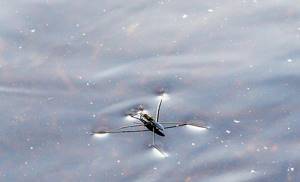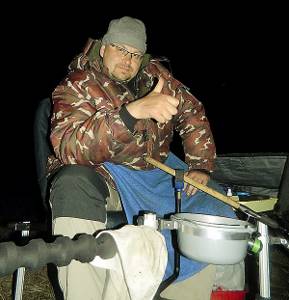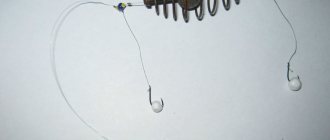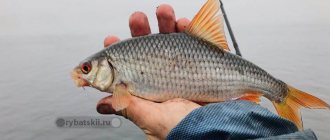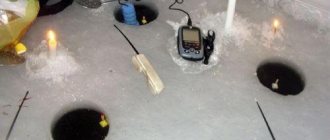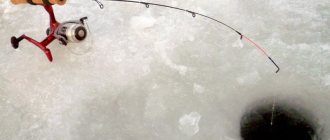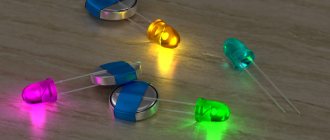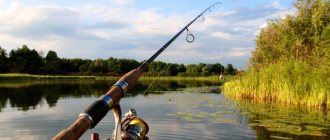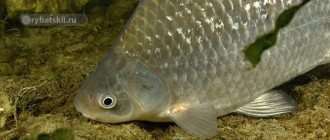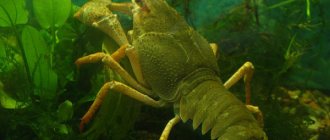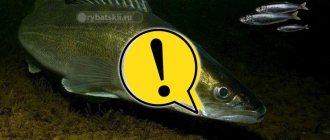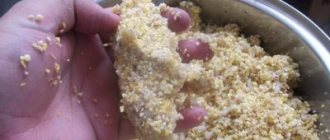Fishing with a feeder at night is something special, both in terms of sensations and in the matter of choosing equipment. Fishing with a feeder at night is something special, both in terms of sensations and in the matter of choosing equipment. And the result, with the right approach, is impressive. Therefore, the night feeder deserves detailed consideration. Let's decide what equipment to take, at what point to cast, and when to start fishing. But first of all, let’s look at why it’s worth fishing with a feeder at night. Just a few reasons, and you will immediately understand the advantages of such fishing.
Night feeder accessories
The set is standard - for feeder fishing at night you will need the following equipment:
- rod with reel
- main line
- leashes
- feeder and bait
- hooks and bait
- fireflies
- landing net and rod under
We propose to consider one by one those elements of equipment that have specifically “night” features. We will only touch upon those components that are the same as during daytime fishing.
Choosing a rod for night fishing
You need a feeder with a fast action, since when darkness falls, it is the large fish that are caught on the hook, but they do not make weak bites.
In addition, at night our potential prey is less careful, so it swallows the bait sharply and decisively. So you need a rod that will quickly exhaust the fish, and this is a fast feeder. Also keep in mind that at night there is little point in casting far, since the “big fish” feed in shallow water. The fishing distance is 30-40 m, no more. Therefore, a rod up to 3.6 m long will be sufficient.
Coil
may be the same as during daytime fishing. Based on practice, we recommend inertia-free universal models - their capabilities are enough to catch even trophy specimens.
Feeder at night
It is better to take a flashlight with one LED.
PHOTO BY ALEXEY MURASHKO
Night feeder fishing is a fascinating, interesting and exciting type of fishing, which is gaining more and more supporters every year. It’s enough to try it once - and sleeping in nature will no longer seem so desirable. After all, night time can be spent more usefully.
The ability to fish in a variety of ways, both from the shore and from a boat, can radically change a fisherman’s life. Fans of feeder fishing are the most impatient in this regard: with the onset of summer, wide opportunities open up for them to use their favorite gear in other conditions - during night fishing. Fishing in pitch darkness gives you the feeling that you are fishing in a completely different body of water.
WHY NIGHT?
For the uninitiated, night fishing looks like an action devoid of any meaning. Instead of a sound healthy sleep, sitting all night, carefully watching the top - is this pure fanaticism? Not at all, if you look closely at the specific behavior of fish in the summer. When the water has heated up to the limit, many representatives of white fish, and primarily bream, carp and crucian carp, switch to feeding at night. With the onset of darkness, the water temperature drops, which has a positive effect on the feeding activity of the fish. At the same time, she becomes bolder, leaves the deep areas that she tries to stick to during the day, and goes out to vast shallows rich in food. Without feeling threatened, the fish actively feeds until dawn.
This statement is also true for most rivers: the same chubs and ides that stick to the riverbed edges during the day, when night falls, come out onto the sandbanks, the depth of which does not exceed half a meter, and actively feed. However, as soon as dawn breaks, the fish goes back to the depths.
In summer, sometimes the situation develops rapidly: the water becomes like fresh milk, the swimming season reaches its climax. Fish that react negatively to such a high temperature of their habitat completely stops feeding during the daytime and switches to feeding at night and twilight hours. The best bite is observed from dawn and lasts until sunrise. Few people know that in a particular place fishing is even better at night. Moreover, it is not at all necessary to look for fish in the distant reaches: bream, crucian carp, carp and even tench happily feed in the coastal zone, providing the opportunity to catch them with delicate picker gear. The situation does not change much with the arrival of autumn. Despite the cooling of the water and the massive migration of fish to deeper areas, the fish feed just as intensively at night, and even in October - November, when the dark period of the day lasts long enough, the active biting of bream and bream occurs precisely at night. By the way, during the day in such places you may not see a single bite.
|
| PHOTO BY ANTON ZHURAVKOV |
If we talk about night fishing, we can highlight a number of advantages for which the angler should stay on the shore and spend a sleepless night enjoying his favorite pastime. ● Comfortable stay near the water. The heat of the day gives way to the coolness of the night, the scorching sun hides behind the horizon. The air temperature stays around +15, +20 °C, due to which many of the nuances of fishing in the heat become irrelevant: the bait does not sour, the bait does not spoil, and the angler is spared the need to constantly plunge into the water to escape the exhausting heat. ● Catchability. The night reservoir often rewards the fisherman with catches that are difficult to imagine during the day. Fishing takes place in shallow water areas and much closer to the shore, which eliminates the need to use long casts and heavy gear. ● Silence. Not everyone practices night fishing, which means that the number of neighboring fishermen and vacationers on the shore is reduced to a minimum. ● Wind. With the onset of darkness, the wind usually subsides and there is complete calm over the reservoir. Fishing in such conditions is greatly simplified, casting accuracy increases, and delicate bites are clearly visible. ● Lack of change. Night allows you to hunt for large fish even in those reservoirs that are characterized by the dominance of small fish. If in daylight the hook with bait is not allowed to reach the bottom by bleak, small roach and silver bream, then you should wait until dark and try fishing at this point again. With a high degree of probability, it can be said that large bream, crucian carp and tench will not keep you waiting, and even two bloodworms or one or two maggots will be able to wait for the “bonus” and not be eaten by small things.
SELECTION OF LOCATION
Most often, the place for night fishing does not differ in any way from the area where fishing takes place during the day. And yet, if we talk about specific points that work best, we should highlight shallow water irrigation bordering the channel edges. When choosing a fishing spot, the angler must carefully study a detailed map of the reservoir and find areas where the flooded river bed passes as close as possible to the shore, that is, at a distance that makes it easy to accurately cast. In my practice, there is a similar place where shallow irrigation (1.5–2.0 meters deep) ends with a sharp drop into the riverbed and in a few steps the depth increases from 2 to 4–4.5 meters. Such a sharp channel edge is a great place for night fishing. It has been repeatedly noticed: if during the day the majority of bites occur either at the bottom of the dump, or somewhat further from it, in the channel ditch itself, then with the onset of night the bites at depth stop: the fish comes out to feed at a depth of two meters, where it is excellently caught. The morning puts everything in its place: watering stops producing bites, but the point located under the dump “comes to life.”
|
| If you have to be distracted from the gear, a bell helps out. PHOTO BY ANTON ZHURAVKOV |
All kinds of shallow coastal areas, abundantly overgrown with a wall of reeds and reeds, are also good. This wall, as a rule, cuts far into the water and extends 25–30 meters from the shore. Wide windows made in such thickets provide an excellent place for night feeder fishing. As a rule, here you don’t even need to study the bottom topography in order to select a specific area: fishing takes place on the border of reeds and clean water. During the daytime, these areas are characterized by a large number of all kinds of small things - roach, bleak, rudd and silver bream, frantically tearing apart any, even the largest bait like canned corn and a couple of dung worms. With the onset of dusk, all this brethren goes to bed together, giving way to truly large fish. The fishing spot is fed abundantly, and after a while fish of decent size begin to bite: bream and bream, carp and carp, crucian carp and tench. As is usually the case, the celebration of life does not last long, exactly until sunrise.
FEEDING TACTICS
When planning night fishing, you should remember that in any body of water there are small fish that are active during the day. When the fishing point is determined and the angler starts feeding, he must understand that the first thing to come up for food will be the small fish. This moment plays a significant role in preparing a place for night fishing. If you feed heavily before dark, then the chances that the bait will attract the target fish will approach zero: the ubiquitous small fish can deal with a large amount of food in a fairly short time. Considering that bait uses a large amount of animal components to maximize its attractive properties - maggots and bloodworms, which will become the main target of small fish - feeding the fishing point should be done already at dusk. This usually happens as follows. Evening fishing begins a few hours before dark; at this time the angler closely monitors the situation. If there are no small fish at the fishing point, and bites bring the target fish - large bream and crucian carp - it makes sense to start feeding and work with the main composition, enriched with a large number of nutritional components. If bites occur literally on every cast, and little things haunt you, the optimal solution would be to work with a depleted base composition, devoid of essential nutrients. The attractive properties of such a composition in the absence of competition from other anglers are at a fairly high level, but collecting fish is not the main goal at the moment. During fishing, the behavior of small fish is monitored. As soon as the bite stops and the bait returns untouched, it’s time to feed the point: the leash is removed, and 10–15 feeders, enriched with aromatics, coarse particles, as well as maggots and bloodworms, are sent to the fishing point one after another. This happens at dusk, when fines reduce food activity to almost zero. This means that the bait will have every chance to wait for a large fish to approach and keep it at the fishing point for a long time.
The approach of large fish, as a rule, begins some time after dark. Analyzing the past seasons of night fishing, I identified two main peaks of biting: after midnight (before 1:00–1:30) and before dawn (from 2:00 until morning twilight). Bites at this time occur, if not on every cast, then quite often. It is for this reason that the fisherman must feed the fishing point without slowing down: a school of fish that approaches eats a large amount of food quickly enough, and in order to keep it at the fishing point, the feeder should be recast frequently, at least once every 5-6 minutes .
|
| PHOTO BY ALEXEY MURASHKO |
When fishing at night, as during the day, the accuracy of casting equipment is of utmost importance. And if our fishing distance is limited by the clip on the reel, then the left-right spread can be significant. It is for this reason that fishing should begin some time before dusk. The angler must carefully determine the guidelines for casting, set the chair in such a way as to ensure maximum comfort, and also fish at this point for some time in order to “place his hand” and get used to casting in a certain direction. In addition, you should turn off your headlamp before casting: a beam of light hitting the butt of the rod during the swing blinds the angler and contributes to his disorientation in space.
EQUIPMENT
Despite all the obvious advantages of night fishing, its main disadvantage - pitch darkness - significantly complicates the fishing process. In order for fishing to take place in the most comfortable conditions for the fisherman, you should take care of high-quality lighting sources. First, it's a headlamp. Preference should be given to models with one powerful LED that has focusing ability. These flashlights provide a powerful and bright stream of white light that perfectly illuminates the work area. Secondly, this is a quality camping lantern. Or rather, two flashlights: one is installed near the working surface or on a table with nozzles and baits laid out around it, and the second is fixed on a stand and installed in such a way that its light is directed at the signal tips of the rods. However, such illumination alone is not enough; you should also acquire high-quality fireflies attached to the tops. This can be done in different ways. Many people prefer ordinary tape, however, in my opinion, the optimal solution would be to use special holders for fireflies, equipped with two grooves: one of them is put on the tip directly on the winding of the pass ring, and the other is clamped to the tip itself. Fixation of fireflies produced in this way is reliable, and the number of overlaps when using them tends to zero.
Alexey Murashko September 8, 2015 at 01:32 pm
Choosing the main line for the night feeder
Here, the best option would be a monofilament line - yes, it has a certain stretchability, but the rod will also have a fast action, that is, it will not smooth out the jerks of large fish very well. These two comparative disadvantages compensate each other, turning into a plus in our case. Due to the short casting distance, the stretchability of the monofilament will not reduce sensitivity, and the bites will be strong.
Although braid can also be chosen as the main line, only then you need to protect the cord with an insert made of feeder gum or a shock leader. In this case, the jerks of the fish will be absorbed.
Fixing a bite in night feeder fishing
In fact, there is no alternative to chemical fireflies. All that remains is to choose the color of the firefly. For example, red fireflies tire your eyes quite quickly. Therefore, the most convenient fireflies are yellow and green. All that remains is to attach the firefly to the top of the feeder. There are three possible mounting options:
- The firefly is attached with thin transparent tape. The method is simple, the firefly does not interfere with casting with the feeder. The only thing is that the brightness is slightly reduced due to the fact that the tape covers the surface of the firefly.
- The firefly is attached using a special plastic firefly mount, which is mounted on the quivertip. This method of fastening has a certain advantage - due to the fluorescent properties of the plastic from which the fastening is made, the glow is more voluminous and brighter, or so it seems. But this method of fastening also has a certain disadvantage. No matter how light the mount itself is, at the moment of casting an additional load appears on the quivertip. This has a particularly negative effect on the thinnest tips.
- The firefly is attached using two rings cut from a silicone tube that comes with the fireflies. The third mounting method is the simplest. The rings are cut from a transparent silicone tube and easily placed on the top, between the tulip and the second ring. You need to put on the rings until the cord or fishing line is passed through the feeder rings. And the firefly is inserted when it starts to get dark.
The firefly is visible quite well, but it is worth noting that the eyes still get tired from constantly looking at a small luminous point. Therefore, so that your eyes don’t get tired so much, you can use additional illumination of the top of the feeder with a flashlight. The flashlight is placed somewhere on the side, with the expectation that the beam from the flashlight will hit the quivertip. The second option is to position the flashlight in such a way that its beam runs parallel to the feeder form. Both options for additional lighting are approximately the same in effectiveness. And the eyes don’t get tired as much as when using only the firefly.

As for the use of various bells and bells in the feeder, this, in general, goes beyond the very aesthetics of feeder fishing. But if additional sound signaling is really required, in the form of a ringing sound, then you can attach a bell on a clothespin to the feeder stand. Although all this is completely unnecessary! If you are going to do night feeder carp fishing, then it is advisable to have a reel with a baitrunner. In any case, pulling the feeder into the water can be avoided.
Choosing leashes for night fishing on the feeder
You can give preference to one of three options:
- Made from thick fishing line with a significant breaking load - for trophy specimens. You just need to fish with such leashes late at night, and closer to dawn they should be changed to thinner ones. Otherwise, even the most careless fish will notice your equipment and may not bite.
- Made from very thin fishing line, with a maximum load of 2.5 kg - in this case, the leashes must be additionally protected from breakage with the already mentioned feeder. An elastic insert 15 cm long is enough to easily catch a trophy specimen or so.
- Made from fluorocarbonate fishing line of medium diameter - its masking properties will come in handy. It is visible to fish 2-2.5 times worse than usual. You can make a fairly thick and reliable leash, for example, 0.2 mm in diameter, and it will be just as invisible as a thin one of 0.1 mm, but its breaking load will be 2 times higher.
Naturally, the most practical option is to prepare all varieties and not in one copy. With a large number of leashes, you can adapt to changes in the time of day and fish with maximum efficiency even all night long.
Leash length
should not be too big - 50 cm is enough. And then, in this case, it already needs to be made from a rigid fishing line, and with it there is no natural play of the bait. Therefore, to avoid alerting potential prey, we recommend not going overboard with the length of the leash.
Choosing hooks and bait for night fishing
If your goal is a trophy specimen, prepare a decent animal bait for it. Excellent options are earthworm and crawler. You can bait them either with an “accordion”, piercing them in several places, or with a “stocking”, passing the fore-end through the entire body. In this case, the size of the hook should be quite large. For a worm you will need No. 10, for a crawl - No. 8.
If you don’t set out to catch a trophy, but just want to fish well at night, take the same hooks and baits that you would use during the day. And here you are guaranteed a variety of choice.
Selecting the remaining equipment for the night feeder
Let’s write just a few words about the feeder and groundbait, the landing net and its kind. They need to be selected in the same way as for daytime fishing. It won’t be difficult to decide, since there are a great variety of baits, we also looked at the specifics of buying feeders, and we paid enough attention to both the species and the landing net. The queue is yours - give preference to high-quality models, and forward to the casting point.
Although there is one important detail left - you need to buy fireflies. These are visual bite indicators - even in the most impenetrable darkness they will show you that the fish is biting. Choosing a firefly is also not a tricky matter.
What kind of fish can be caught on a night feeder?
Quite often, it is when fishing at night on a feeder that you can achieve good results. In the summer, and not only that, many species of fish switch to feeding at night. This is due not only to the increased water temperature in summer, but also to certain features of the reservoir, including the presence of predators in the reservoir that hunt during the daytime. And no matter how large a peaceful fish is, on an instinctive level, it is afraid of a predator and tries to stay in safe places when the predator is active, rather than feed.
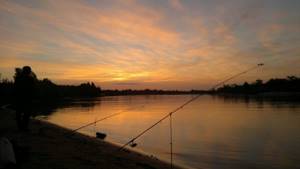
At night, carp, bream, crucian carp, silver bream, and chub are caught on the feeder. Moreover, the intensity of the bite at night can significantly exceed the number of bites during the day. And specimens caught at night often exceed the size of fish that bite during the day.
How to find and prepare a place for night fishing on a feeder
Finding a place is simple: you need an area with a familiar bottom, without tall grass, bushes and other thickets near the water that interfere in poor visibility conditions.
Of course, all such plant obstructions can be removed by cutting or tearing them out. And time will need to be spent exploring the bottom, if the place is unfamiliar. So come for night fishing not even in the evening, but 2.5-3 hours before sunset. It will take about 60-90 minutes to study the bottom, 30-60 to prepare the shore and another 30-60 to prepare bait and feed.
At the same time, the fishing point (attention, important point) is not the exit from the edge and not a hole, as during the day. At night, cast closer to the shore, on a flat or even sloping bottom, where the depth is no more than 3 m.
To ensure the accuracy of bait delivery to the fishing point in poor visibility conditions, you need to create a visual reference for yourself. The easiest way is to notice some object on the opposite bank and focus on it. Although at night this method may fail. A more reliable option is luminous buoys, but they cost money and still need to be pulled out after fishing.
Therefore, we offer a simple way to mark a landmark for night fishing on a feeder:
- Before dark you determine the bait delivery point.
- Record your footprints in the place where you will stand during the night casts.
- Place the landing net between them so that it faces the bait delivery point.
- When darkness falls, stand in the direction of casting and see everything perfectly.
Features of catching bream at night on a feeder
Many people prefer to fish at night because they can find cool spots. But in the dark you can’t always see the bite, and lighting is needed to set the bait.
For convenience when night feeder fishing, it is important to have a headlamp with you.
Its advantage is that your hands are free and the light is directed to the desired point. Just make sure that the beam does not fall on the water, but passes a little higher. It may scare the bream. Don't forget to use fireflies.
Silence must be maintained. The noise may alert the fish. This will reduce the catch. During the day, large bream stand in holes at depth, and it is not always possible to cast the tackle to the required distance. There are more chances to take a trophy to the feeder at night. At this time, the bream goes to feed closer to the shore.
In the dark it is more difficult to find equipment, groundbait and bait, so everything should be at hand.
When to start night fishing on a feeder
We have already described above when to arrive at the place and prepare for fishing. Now let's move directly to the casting schedule:
- 23:00-00:00 - time of the evening bite, more sluggish and rare than during the day. Casting should be infrequent, with breaks of 15 minutes. And all because the bites will occur once every 10-20 minutes.
- 00:00-03:00 is “dead” time for all fish except catfish. If this is what you are fishing for, you can make casts more often - up to one every 10 minutes. If not, continue sending the feeder to the point at the same pace - every 15 minutes.
- From 03:00 is the time for active night biting. Gradually increase the frequency of casts; the interval between them during this period can reach 5 minutes. At this stage, it is worth adding dry mixture to the bait so that it washes out faster, so leave it in advance. Fish until one small fish begins to bite - a signal that the “big fish” have gone to depth.
Night feeder is a treat worth trying: make sure we're right.
Choosing a place for fishing and preparing it
It is possible to determine a promising location only if you have basic knowledge about the reservoir: the type of bottom, the presence of whirlpools, holes and shoals. It is advisable to select areas with minimal current, a bottom made of clay or sand and without excessive thickets at the bottom. It is better to choose a place with a flat shore; the main factor is a simple approach to the water. The presence of protruding tree roots, boulders, stumps, stones, and reeds will complicate movement and can provoke loud noises. They prepare the place for night fishing before dark and immediately begin to feed the area.
Read more
What is feedergam?
In the dark it is difficult to determine the baited place and throw the tackle there. To make your task easier, you should select a site in advance and install a large illuminated float on it. An inflatable boat will be useful for installation.
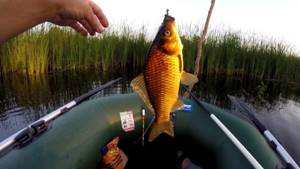
When setting up a fishing spot, fishing gear must be arranged so that it is not within walking distance, but at arm's length
At night, luminous floats perform the task of beacons; they are used as a guide when casting. One feeder is installed on the left, and the second on the right. To control the casting distance, put an elastic band on the spool on top of the line; it slows down the movement of the line beyond the required length. The feeder will always end up in the feeding area.

